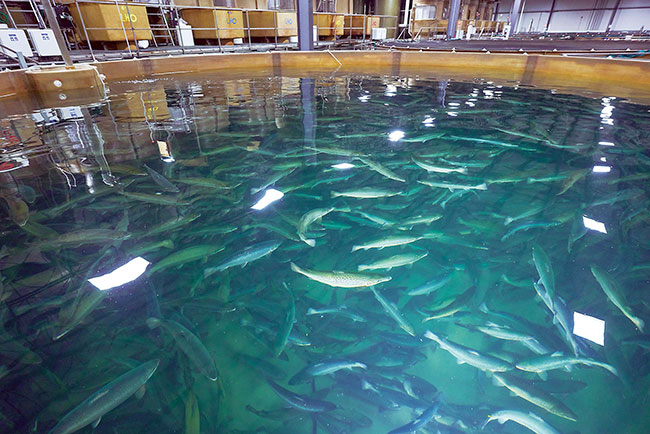
Different reasons for swimming earth’s waters
December 14, 2022
By Julia Hollister
While farmed salmon is emerging in markets and on dinner plates, it is sparking discussions with wild salmon devotees.
 Underwater salmon swimming in grow-out tank.
(Photo: AquaBounty Technologies Inc.)
Underwater salmon swimming in grow-out tank.
(Photo: AquaBounty Technologies Inc.) The United Nations Food and Agriculture Organization forecasts a global seafood shortage of 50-80 million tons by 2030. One answer is aquaculture.
By 2030, the world’s population is predicted to increase by another two billion. The amount of food that will be consumed in the world in the next 50 years will exceed all the food eaten in human history to date.
Today, more than half of all fish and seafood consumed in the world originates from aquaculture. Farmed Atlantic salmon can help meet the growing global seafood demand, and take the pressure off wild stocks.
Oliver Cox, with the Maine Fish and Wildlife Service, has another view of farmed salmon in his state.
“Aquaculture has also been pointed to as having a negative effect on Maine wild Atlantic salmon associated to disease and parasites like sea lice,” he said. “We do encounter aquaculture Atlantic salmon that have escaped from their net pen from time to time. When we catch them at a fish way we can identify them by their appearance and the scale patterns.”
However, he added, “The relationship with Cooke Aquaculture and the restoration community has many angles, but, overall, it is positive and even collaborative at times.”
“We raise our Atlantic salmon in land-based, closed containment farms designed with multiple layers of containment and which utilize Recirculating Aquaculture Systems (RAS), that are good for the fish and the environment,” said Sylvia Wulf, president and CEO of AquaBounty Technologies Inc., based in Maynard, Massachusetts. “Like salmon in the wild, our salmon school and swim naturally. But unlike in the wild, or sea-cage farms, our carefully monitored production systems and indoor tanks protect the salmon from disease and contaminants, eliminating the need for antibiotics.”
Salmon eggs arrive at the Albany, Ind. farm from the breeding and egg production facility in Rollo Bay, P.E.I., Canada and are placed into hatchery incubators. Soon after hatching, these “fry” are moved to small tanks where they begin to actively swim and feed on a special starter diet to help them thrive. AquaBounty raises all-female and sterile fish for market.
When the juvenile salmon reach 50-100 grams, they are transferred to carefully monitored, circular grow-out tanks with plenty of room to grow, school and swim naturally. Each tank is fitted with a jump net to keep the fish safe. When the salmon reach 500 grams, they are transferred to larger tanks where they grow to harvest weight (4–5 kilograms).
The production cycle is an 18 -to-20-month process from egg hatch to harvest weight.
Wulf said the global demand for salmon exceeds the supply, and currently, approximately 90 per cent of all farmed Atlantic salmon consumed in the U.S. is imported from overseas. By raising the salmon on land-based farms, AquaBounty is expanding the volume of domestically produced Atlantic salmon. Raising the fish closer to major consumer markets, is reducing the transportation distance to market, resulting in a fresher product with a smaller carbon footprint than salmon being imported into the U.S. by air freight.
“We have seen an increase in proposals to build more land-based salmon farms in the U.S, but these have been delayed for a variety of reasons,” said Wulf. “This delay includes the permitting process and the rapidly changing economic landscape coming out of the COVID-19 pandemic and the war in Ukraine. Traditional sea-cage farmers are trying to increase production volumes but are challenged in this regard as well by the same constraints.”
Wulf said the biggest challenge facing salmon farmers in 2022 is the volatile economic situation that is delaying the building of new farms by driving up the costs of inputs, such as building materials and equipment. Shortages are another challenge, whether that is for raw materials or finished products, such as technology components. Sea-cage farmers face detrimental environmental changes and constraints due to stricter regulations and changes in taxation.
At Mollie Stones, a high-end grocery and fish market in San Francisco, customers have a choice of salmon at the counter.
“Most of our customers want the wild salmon over the farmed but price has a definite effect on the choice,” said Art Mortenenegro, fish monger at Mollie Stones. “Wild salmon sells for US$37.30 a pound and a pound of farmed variety is $25.90. In my opinion, the farmed salmon – fed on ground fish and potatoes – tastes just as good as the wild type.”
Donavon Hilligoss, community supported fishery director with Sitka Salmon Shares in Alaska said harvesting wild-caught seafood using small boats and low-impact gear has minimal effect on the environment.
“In fact, it could be said that small boat fishermen are some of the best stewards of our oceans,” he said. “Many are multi-generational and live in the coastal communities where they fish. These fishermen also use gear that limits bycatch and they avoid environmentally sensitive areas. They are the most well-managed in the world with the sustainability of the ocean’s resources as the guiding tenant. ”
Advertisement
- New SEAfood Act to support sustainable seafood offshore in U.S.
- Viewpoint: Washington State got it wrong





